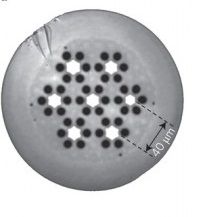New 255Tbps Fibre Optic Technology Can Transfer Three Times Current Internet Data Traffic
Experimental fibre optics can transfer a movie in 0.03 milliseconds

Researchers have developed a new fibre optic technology capable of transferring data at a rate of 255 terabits per second (Tbps) - more data than the total traffic flowing across the internet at peak time.
A collaboration between teams from Eindhoven University of Technology and the University of Central Florida broke the world optical fibre data speed record with an innovation that could one day see general use.
According to a report from Intel in 2013, 10.6 terabytes of IP data is transferred across the globe every second - roughly one third of the 32 terabytes per second that the new experimental multi-core optical fibre is capable of.
The findings are described in the latest edition of the journal Nature Photonics as "like going from a one-way road to a seven-lane highway", given that the data is transferred on a single glass fibre.

Researchers described the new type of optical fibre as "allowing 21 times more bandwidth than currently available in communication networks."
At such speeds, it is possible to transfer a 1GB movie in 0.03 milliseconds, or a one terabyte file – 1,000GB of data – in just 0.03 seconds.
The researchers created a multi-core optical fibre to overcome the limitations of traditional single-mode fibres, to make it "as if three cars can drive on top of each other in the same lane".
Experimental setups in the past have reached significant data transfer speeds, such as the 43Tbps reached by the Technical University of Denmark earlier this year. However, the techniques used were recognised as being too complicated commercial use.
Multi-core optical fibres could theoretically replace the current single-mode fibres used to carry the world's internet traffic, however millions of miles of cabling would need to be replaced.
It is more likely multi-core optical fibres will be introduced on top of the existing infrastructure to meet the growing demand for fast internet access, fuelled by the widespread adoption of smartphones in massive markets like India and China.
© Copyright IBTimes 2025. All rights reserved.






















